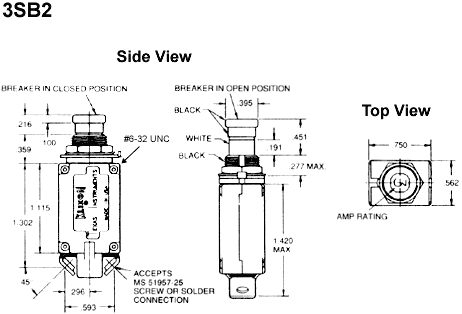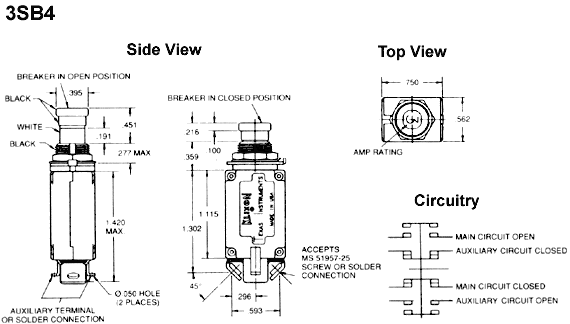 |
|
Klixon 3SB Series |
|
|
Aircraft Circuit Breakers |
| – |
|
|
| – |
|
|
|
 |
|
|
 |
|
|
About these pages
Sensata Technologies is in the process of updating our web pages. Please bear with us during this process. If you have questions or comments, we’d like to hear from you. Please see contact us.
|
|
|
We offer a derivative of our 7274 style circuit breaker for simulators, trainers, and cockpit mock–ups. |
Part Number |
7274-63D
Dummy breaker, non–functional 7274-2 style
|
7274-64PS
Physical sample, 7274-2 style with operational pushbutton, can measure continuity across terminals
|
7274-65PS
Physical sample, 7274-11 style with operational pushbutton, can measure continuity across terminals
|
|
 |
 |
 |
Sensata > Products > Klixon Brand > Circuit Breakers > Aircraft >
Klixon® 3SB series
Simulators, single–phase, low amp, quick trip
| Features and Overview |
/\ Top |
|
• |
Low amperage |
• |
Fast trip response |
• |
High performance (shock and vibration) |
• |
Lower total system cost |
• |
Tactile feel equivalent to industry accepted aircraft circuit breakers |
|
• |
Packaged in military standard configuration |
• |
Optional panel mount configuration, replaceable amp rating inserts (reference part #27515 when ordering), auxiliary switch |
|
|
Klixon 3SB series simulator circuit
breaker was developed by Sensata Technologies to meet the growing needs of the commercial
and military simulator industry. Due to the high operational coast of live training, more
and more training is being conducted on simulators. The realism and
complexity of tomorrow’s simulators will require a circuit breaker that can provide
the same "look and feel" of industry accepted circuit breakers in order to
create a superior training environment.
|
|
 |
 |
 |
|
The 3SB electro mechanical devices provide fast trip response with low current draw at
28 VDC. For adaptability to aircraft cockpit panel mounting, they are packaged in a
standard MS 26574 style thermal circuit breaker configuration. This fast trip/low
current performance provides the opportunity for system level savings. It enables
the designer to potentially downsize the system power source and eliminate expensive
I/O boards or other electronics while also reducing the amount of cabling required.
Changes in training schemes normally entail system rewiring to reconfigure the simulator,
which becomes labor intensive and costly. With the incorporation of a 3SB device the
training changes can easily be achieved through system software — without the time and
cost associated with rewiring.
Klixon simulator circuit breakers also provide the same tactile feel as standard Mil
qualified breakers for superior training realism.
Klixon circuit breakers offer flexibility by offering replaceable ampere rating
inserts. (To order different amp rating insert tabs, reference part number 27515.) Attached to the top of the pushbutton actuator, they match the current rating used in the actual aircraft. These inserts can be rotated within the pushbutton to meet your cockpit configuration needs.
An optional auxiliary switch for remote indications and a variety of connection alternatives
are also available.
|
| Performance Characteristics |
/\ Top |
|
Vibration |
5 G maximum, 50–500 Hz |
Mechanical Shock |
5G |
Acceleration |
5G |
Weight |
30 grams maximum |
Endurance |
25000 mechanical cycles, no load
1000 Electrical trip cycles minimum at 28 VDC |
Open and Reset Force |
5 lb. maximum |
Calibration at 25°C |
200mA maximum
Current draw at 28 VDC
3 seconds maximum trip time |
| Drawings and Dimensions For Reference Only |
/\ Top |
|

 |
| Spec Sheets For Our Most Popular Devices |
/\ Top |
|
| Specification sheets contain detailed drawings, amp ratings, characteristics, and more... |
3SBX |
Device Type |
Spec Sheet |
3SB2 |
- - - |
|
3SB4 |
- - - |
|
| For others, please contact us. |
|